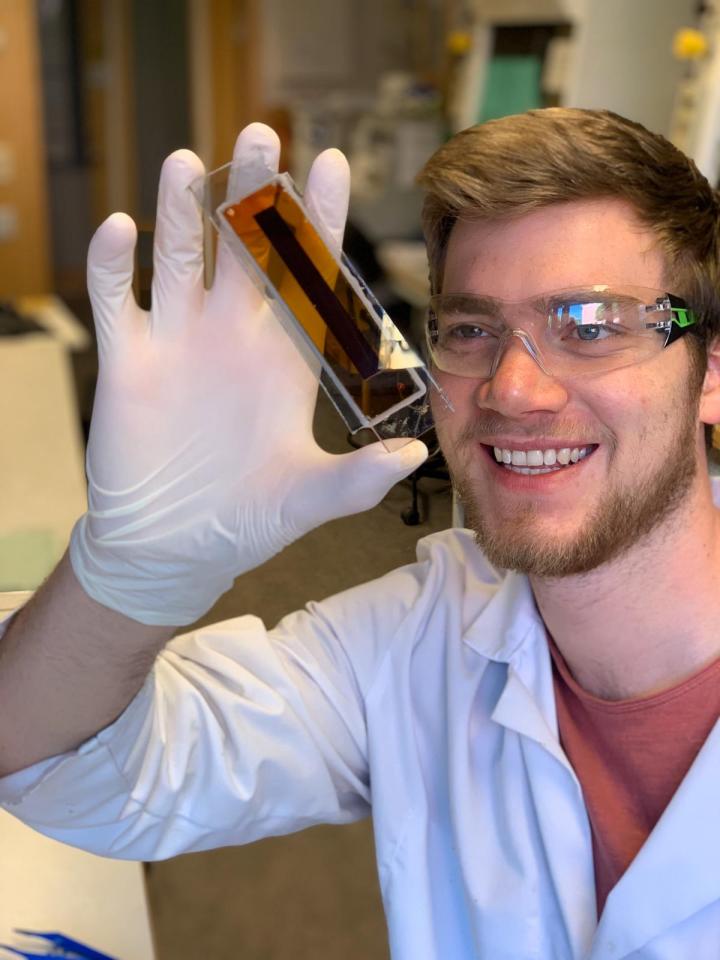Hybrid Solar Cells
Providing their efficiency is increased, the new generation of “hybrid” solar cells, which combine the versatility of molecules with robust solid state semiconductors, offer an alternative to established technology which promise greater flexibility (in terms of materials and applications) and sustainability and lower cost than conventional crystalline silicon and thin film devices. There has been much hype recently surrounding new breakthrough in light-absorbing materials, such as organolead halide perovksites and tandem organic photovoltaics, which have led to a step-change in the power conversion efficiency.
Coordination Materials as Charge Transport Materials
New research approach towards highly efficient, sustainable and robust solar technology based on new transition metal coordination complexes and and other systems. These nanoscale materials are straightforward to assemble and manipulate from molecular building blocks, consisting of a metal coordination complex, preferably based on earth-abundant transition metals (Cu, Fe, Ni), and organic/inorganic bridging and coordinating ligands. This structure is not only amenable to self-assembly, but also enables multifunctionality (electronic/magnetic/reactivity) within a single material by simple modifications to the steric and electron donating/withdrawing properties of the ligand, and/or the coordination geometry and number or electronic configuration of the metal centre.
Ambient Light Photovoltaics
The impending implementation of billions of Internet of Things and wireless sensor network deviceshas the potential to be the next digital revolution, if energy consumption and sustainability con-straints can be overcome. Ambient photovoltaics provide vast universal energy that can be used torealise near-perpetual intelligent IoT devices that can directly transform diffused light energy intocomputational inferences based on artificial neural networks and machine learning.
The challenges of sustainable energy conversion to meet the global energy demand using sunlight are the focus of a massive research effort. With the costs of Si-based solar panels decreasing in cost, research challenges lie in developing high efficiency materials or lightweight, flexible, robust devices. Providing their efficiency is increased, the new generation of “hybrid” solar cells, which combine the versatility of molecules with robust solid state semiconductors, offer an alternative to established technology which promise greater flexibility (in terms of materials and applications) and sustainability and lower cost than conventional crystalline silicon and thin film devices. There has been much hype recently surrounding new breakthrough in light-absorbing materials, such as organolead halide perovksites and tandem organic photovoltaics, which have led to a step-change in the power conversion efficiency. However, for these technologies to breakthrough commercially, the remaining challenges of reliability and sustainability still need addressing. Achieving this requires improvements to the materials within the devices which are responsible for charge-transport and better understanding of how these materials interact with the other components.
One such technology, dye-sensitized solar cells (DSCs) are more suitable to low-light conditions, giving greater sunlight to electrical energy conversion over the course of a day or year compared to c-Si, making them particularly attractive for applications in Northern Europe. Research into DSCs was thriving until recently, mostly through developing better light-harvesting molecules. However, the field stagnated because insufficient attention was placed on the component responsible for transporting charge between the electrodes, an electrolyte solution containing iodine, which limited both the performance, stability and the scale of the technology. Werecently introduced Cu complexes as a redox relay, which is capable of successfully regenerating dyes at only 0.1 eV overpotential. Strikingly, under 1000 lux indoor illumination their efficiency is 34 %, opening new areas of application. To address the limitation in stability and to enable large area production, the liquid electrolyte had to be replaced by a solid charge-transport material. Our recent breakthrough using copper coordination complexes as charge-transport materials lead to the currently most efficient solid-state DSC (ssDSC), with stable efficiencies of over 11%. The next breakthrough requires the development of new solid-state charge-transport materials which rapidly intercept the charge from the light-absorbing material, are highly conductive, readily tuned, can be prepared on a large scale and solution-processable.

Most recently, the Freitag Lab opened an entirely new direction in indoor device design and application and has now used these new light harvesters to create “smart zombies”.
These are wireless devices that harvest indoor light at extremely high efficiencies. Through the unique combination of artificial intelligence and automated learning, we developed a photovoltaic system that adaptively uses the available energy and thus ultimately provides an efficient source of sustainable energy to devices. Our discovery enables the direct transformation from diffuse light to structured information.